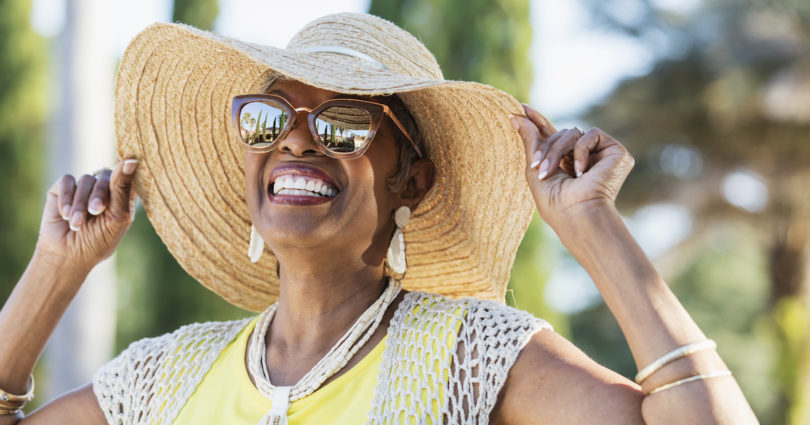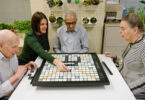Here in Toronto we have gone from nasty grey days to glorious heat and sunshine in just a few weeks. And it feels amazing.
Our long winter means I want to get outside ASAP. I know I’m not the only one who wants to shake off the winter cobwebs with some fresh air!
But before we do, remember these tips from a dermatologist to help us protect our skin from the sun.
A history of sunburns increases the risk of skin cancer, including melanomas. Sun exposure can also cause wrinkles, dry skin and age spots.
Dr. Mary McKenzie, dermatologist in Sunnybrook’s Melanoma Clinic, recommends using a sunscreen 30 SPF or higher if you will be outside. Some make-up and face creams now have SPF between 15 and 30 – that’s OK for your daily use. (For example, if you are just going from your house to car to head to the grocery story and back but not spending time outside, that makeup will provide enough coverage.) If you’ll be outside longer — to take a walk, sit in the backyard or wait in line outside of the hardware store, reach for an SPF 30 or higher. If your skin gets irritated after applying sunscreen, try a mineral formula. If you tend to break out after applying sunscreen, try a formula that is made for acne-prone skin.
While skin cancer is more common in people with light or pale skin, red hair or freckled skin, people with other skin types and tones are not without risk. People of all complexions should also wear sunscreen daily and practice sun safety.
Lips are super sensitive, and should be protected from the sun, particularly when you are near water (which reflects the sun). Try a chapstick with 30 SPF or more. And reapply often. Some colour lipsticks also offer SPF protection.
Don’t forget to apply sunscreen to the commonly missed places — your ears, tops of your feet and hands. Wear a hat to protect the top of your scalp (in particular if your hair is thin, fair or if you are bald) or apply sunscreen on the top of your head. Dr. McKenzie says the top of the head is a common trouble spot when it comes to skin cancers.
Cover up or find shade
There are ways to cover up besides sunscreen. Wear light, long-sleeve clothing to protect your skin. Linens are nice and airy. Or there’s sun-protective clothing available too. Wear a hat. Avoid the outdoors mid-afternoon when the sun is at its peak. Seek shade. Carry an umbrella.
And wear shades
Dr. McKenzie doesn’t recommend putting sunscreen on your eyelids – sweat can make the sunscreen run into the eyes and sting. Sunglasses do double duty – they protect the eyeballs and the eyelids. So don’t forget them!
If you find your eyes do sting (often from sunscreen mixed with forehead sweat) try a mineral sunscreen.
Rub it in
Be sure to put a thick coating of sunscreen on your skin (about a shot glass worth) and rub it in. If you are using a spray sunscreen, keep the bottle close to the skin when you spray. “With the spray bottles, it’s a little harder to tell if you’ve missed a spot,” Dr. McKenzie says. “Be sure to still rub it in and use enough sunscreen.” Don’t spray it in the wind – you want to make sure it’s getting onto your body.
After sun
Is there anything we can do to feel better or minimize a sunburn’s effects? Dr. McKenzie says try a mild cortisone cream, available over-the-counter, to reduce the inflammation. But, most importantly, try to avoid the burn by using sunscreen and following the other tips above.
(This post was reviewed and updated April 28, 2023)









The one concern I have about this article is the promotion of sunscreen use. I feel that the chemicals used to make these sunscreens are just as cancerous as the UV rays, maybe more so when heat from the sun interacts with the chemical. There is also a problem with the scent, and the lotion or cream getting in my eyes and breathing it in. A mineral base is no good for me as I discovered I was allergic to mineral oil. Nonetheless, I had quite the eye opener when my face got burnt – it turned pink, and now I have a permanent “mask” on my face that contours the shape of my sunglasses. The result is permanent skin pigmentation damage, so I worry about the risk of skin cancer in future years. I did not realize that wearing a sunhat with large brim and sunglasses does not protect your face. The outside of my hands have also taken a beating; point well taken about missing spots. I do wear long-sleeve blouses now in the sun.
Thank you for reading! I try to choose long-sleeve shirts too (though it’s so hot now, I’m opting for air-conditioned spaces and avoiding the outdoors!) Our dermatologists answered some frequently asked questions about sunscreen – including concern about its safety – here https://sunnybrook.ca/content/?page=sunscreen-selfie